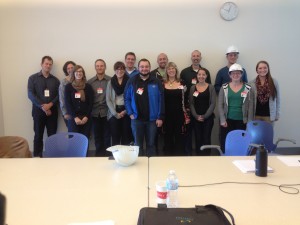Yesterday marked a day of protest with rallies in several major Canadian cities and a flurry to tweets. The protests were about evidence based policy decisions and the erosion of support for science in Canada. From my perspective, there are at least 3 major and worrisome problems with the current national government policies with regards to science. One is downright alarming. And if you don’t think this matters to you because you aren’t a scientist, you are totally wrong. In a couple of blogs, I thought I’d outline what my concerns are and WHY they matter outside of the hallowed halls of a university…
It isn’t often that science policies in Canada make international news. But after an interview request by the Swedish public radio, I realized that Canada is making science news in a bad way. The muzzling of governmental scientists may seem like a minor issue, after all they aren’t guaranteed academic freedom like tenured professors are. Yet, their ability to discuss their research is critical for public policy decisions. This new practice, put in place by our current government, is what is really behind Stand Up for Science but I think this is the tip of the iceberg in terms of a government anti-science climate.
Government scientists work in major agencies (think Department of Fisheries and Oceans, Environment Canada..) but perform research in service of government policy needs. They are funded by the Canadian government and produce good quality science. Like university professors, they do research, attend conferences, publish papers. But their focus does not include teaching and instead they focus on real world problems that Canada needs to deal with. Think water and air quality guidelines, for example. Their research and expertise is meant to provide Canada with the tools to make sound policy decision that protect our health, environment, natural resources, and economy. Important right?
One way that government scientists help with public policy is when they speak to the public. This is often done through media interviews and contributions to news stories. This discourse helps inform the public, who in the end have a voice in our government policies. Yet, the government has instituted media policies in place that inhibit that exchange and in some cases, appear to block government scientists from speaking about their research.
Democracy Watch and the Environmental Law Clinic at UVic have, based on a report issued from the clinic, have filed a complaint with the federal Information Commissioner. The complaint is currently being investigated. The effects of these new policies are chilling. Government scientists don’t feel that they can speak freely about their work. But here’s the catch – TAXPAYERS are the ones who PAY for the research so why can’t they hear about the results? I really don’t get it. How bad is it? Well in my own field, aquatic toxicology, we have an international society that brings together industry, government and academic (university based) researchers. At a recent annual meeting, the government scientists from Canada were given some directions in answering questions. One reply? “I am a scientist. I’m not in a position to answer that question, but I’d be happy to refer you to the appropriate spokesperson”. Personally, I don’t want to hear some canned answer from a spokesperson. I want to hear from the person doing the research. In the end, they know it best.
So why should the public care? Beyond the fact that this is a democracy, that the public paid for the research, the public should be interested in finding out about the science performed by the government research labs. This will help frame the public discussion about major policy decisions, help the public understand major issues needing attention, and clarify what science knows about these issues. And the public will not be reading science journal, they will not be attending science conferences but they do read the news. It is silly to think they could get the information otherwise, but then again, it seems like that is the point. And that is why everyone should care.
Interested in this? check out Democracy Watch: http://democracywatch.ca/campaigns/tell-harper-to-stop-muzzling-scientists/
The UVic Environmental Law Clinic and Democracy Watch report and request to the Information Commissioner:
http://www.elc.uvic.ca/press/documents/2012-03-04-Democracy-Watch_OIPLtr_Feb20.13-with-attachment.pdf


